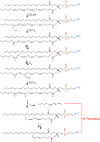Iron catalysis of lipid peroxidation in ferroptosis: Regulated enzymatic or random free radical reaction?
- PMID: 30217775
- PMCID: PMC6555767
- DOI: 10.1016/j.freeradbiomed.2018.09.008
Iron catalysis of lipid peroxidation in ferroptosis: Regulated enzymatic or random free radical reaction?
Abstract
Duality of iron as an essential cofactor of many enzymatic metabolic processes and as a catalyst of poorly controlled redox-cycling reactions defines its possible biological beneficial and hazardous role in the body. In this review, we discuss these two "faces" of iron in a newly conceptualized program of regulated cell death, ferroptosis. Ferroptosis is a genetically programmed iron-dependent form of regulated cell death driven by enhanced lipid peroxidation and insufficient capacity of thiol-dependent mechanisms (glutathione peroxidase 4, GPX4) to eliminate hydroperoxy-lipids. We present arguments favoring the enzymatic mechanisms of ferroptotically engaged non-heme iron of 15-lipoxygenases (15-LOX) in complexes with phosphatidylethanolamine binding protein 1 (PEBP1) as a catalyst of highly selective and specific oxidation reactions of arachidonoyl- (AA) and adrenoyl-phosphatidylethanolamines (PE). We discuss possible role of iron chaperons as control mechanisms for guided iron delivery directly to their "protein clients" thus limiting non-enzymatic redox-cycling reactions. We also consider opportunities of loosely-bound iron to contribute to the production of pro-ferroptotic lipid oxidation products. Finally, we propose a two-stage iron-dependent mechanism for iron in ferroptosis by combining its catalytic role in the 15-LOX-driven production of 15-hydroperoxy-AA-PE (HOO-AA-PE) as well as possible involvement of loosely-bound iron in oxidative cleavage of HOO-AA-PE to oxidatively truncated electrophiles capable of attacking nucleophilic targets in yet to be identified proteins leading to cell demise.
Keywords: 15-lipoxygenase; Ferroptosis; GPX4; Glutathione; Hydroperoxy-arachidonoyl-phosphatidylethanolamine; Iron; Iron chaperons; Lipid peroxidation.
Copyright © 2018 Elsevier Inc. All rights reserved.
Figures






Similar articles
-
Formation of protein adducts with Hydroperoxy-PE electrophilic cleavage products during ferroptosis.Redox Biol. 2023 Jul;63:102758. doi: 10.1016/j.redox.2023.102758. Epub 2023 May 22. Redox Biol. 2023. PMID: 37245287 Free PMC article.
-
NO● Represses the Oxygenation of Arachidonoyl PE by 15LOX/PEBP1: Mechanism and Role in Ferroptosis.Int J Mol Sci. 2021 May 17;22(10):5253. doi: 10.3390/ijms22105253. Int J Mol Sci. 2021. PMID: 34067535 Free PMC article.
-
Achieving Life through Death: Redox Biology of Lipid Peroxidation in Ferroptosis.Cell Chem Biol. 2020 Apr 16;27(4):387-408. doi: 10.1016/j.chembiol.2020.03.014. Epub 2020 Apr 9. Cell Chem Biol. 2020. PMID: 32275865 Free PMC article. Review.
-
Empowerment of 15-Lipoxygenase Catalytic Competence in Selective Oxidation of Membrane ETE-PE to Ferroptotic Death Signals, HpETE-PE.J Am Chem Soc. 2018 Dec 26;140(51):17835-17839. doi: 10.1021/jacs.8b09913. Epub 2018 Dec 17. J Am Chem Soc. 2018. PMID: 30525572 Free PMC article.
-
Redox Epiphospholipidome in Programmed Cell Death Signaling: Catalytic Mechanisms and Regulation.Front Endocrinol (Lausanne). 2021 Feb 19;11:628079. doi: 10.3389/fendo.2020.628079. eCollection 2020. Front Endocrinol (Lausanne). 2021. PMID: 33679610 Free PMC article. Review.
Cited by
-
Iron and Cancer: 2020 Vision.Cancer Res. 2020 Dec 15;80(24):5435-5448. doi: 10.1158/0008-5472.CAN-20-2017. Epub 2020 Sep 14. Cancer Res. 2020. PMID: 32928919 Free PMC article. Review.
-
GPX4 Alleviates Diabetes Mellitus-Induced Erectile Dysfunction by Inhibiting Ferroptosis.Antioxidants (Basel). 2022 Sep 25;11(10):1896. doi: 10.3390/antiox11101896. Antioxidants (Basel). 2022. PMID: 36290619 Free PMC article.
-
Ferroptosis Enhanced Diabetic Renal Tubular Injury via HIF-1α/HO-1 Pathway in db/db Mice.Front Endocrinol (Lausanne). 2021 Feb 18;12:626390. doi: 10.3389/fendo.2021.626390. eCollection 2021. Front Endocrinol (Lausanne). 2021. PMID: 33679620 Free PMC article.
-
Iron Accumulation and Lipid Peroxidation in the Aging Retina: Implication of Ferroptosis in Age-Related Macular Degeneration.Aging Dis. 2021 Apr 1;12(2):529-551. doi: 10.14336/AD.2020.0912. eCollection 2021 Apr. Aging Dis. 2021. PMID: 33815881 Free PMC article. Review.
-
Die hard: cell death mechanisms and their implications in nanotoxicology.Toxicol Sci. 2023 Feb 8;192(2):141-54. doi: 10.1093/toxsci/kfad008. Online ahead of print. Toxicol Sci. 2023. PMID: 36752525 Free PMC article.
References
Publication types
MeSH terms
Substances
Grants and funding
- R01 CA165065/CA/NCI NIH HHS/United States
- R01 ES020693/ES/NIEHS NIH HHS/United States
- U19 AI068021/AI/NIAID NIH HHS/United States
- R37 NS061817/NS/NINDS NIH HHS/United States
- R01 NS076511/NS/NINDS NIH HHS/United States
- R01 HL136143/HL/NHLBI NIH HHS/United States
- P30 DA035778/DA/NIDA NIH HHS/United States
- P01 HL114453/HL/NHLBI NIH HHS/United States
- R01 GM113908/GM/NIGMS NIH HHS/United States
- R01 HL086884/HL/NHLBI NIH HHS/United States
- R01 NS061817/NS/NINDS NIH HHS/United States
- P41 GM103712/GM/NIGMS NIH HHS/United States
LinkOut - more resources
Full Text Sources
Other Literature Sources
Medical
Research Materials
Miscellaneous

